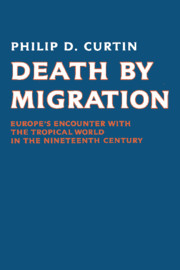Book contents
- Frontmatter
- Contents
- List of Tables, Figures, and Maps
- Preface
- List of Abbreviations
- 1 The Mortality Revolution and the Tropical World: Relocation Costs in the Early Nineteenth Century
- 2 Sanitation and Tropical Hygiene at Midcentury
- 3 Killing Diseases of the Tropical World
- 4 Relocation Costs in the Late Nineteenth Century
- 5 The Revolution in Hygiene and Tropical Medicine
- 6 The Pursuit of Disease, 1870–1914
- Conclusion
- Appendix Statistical Tables
- Bibliography
- Index
4 - Relocation Costs in the Late Nineteenth Century
Published online by Cambridge University Press: 29 March 2010
- Frontmatter
- Contents
- List of Tables, Figures, and Maps
- Preface
- List of Abbreviations
- 1 The Mortality Revolution and the Tropical World: Relocation Costs in the Early Nineteenth Century
- 2 Sanitation and Tropical Hygiene at Midcentury
- 3 Killing Diseases of the Tropical World
- 4 Relocation Costs in the Late Nineteenth Century
- 5 The Revolution in Hygiene and Tropical Medicine
- 6 The Pursuit of Disease, 1870–1914
- Conclusion
- Appendix Statistical Tables
- Bibliography
- Index
Summary
In the middle decades of the nineteenth century, military death rates in the tropical world dropped more rapidly in absolute terms than they would ever do again. Between 1837–46 and 1859–68, the annual average death rate in the Jamaica Command declined by 45 per thousand; in Algeria, by 61 per thousand; in India, by 31 per thousand. These figures for India and Algeria may overstate the case somewhat, because they are based on a period of frequent warfare, on one hand, and a period of comparative peace, on the other; but even at half that figure, the proposition would still be true. Experience made these achievements possible. Medical authorities responded to empirical observation, even though the underlying general principle was barely suspected – if not completely misunderstood.
The half-century before the First World War was different. Empirical advances continued, but their consequences were statistically less impressive through the 1870s and 1880s. The annual decline in death rates over the midcentury had been in the range of 2.5 to 4.5 percent per year. The annual decline in death rates from the 1860s to the 1890s fell to 0.9 to 1.6 percent per year. Over the midcentury, the greatest gains in mortality occurred overseas, in the West Indies and Algeria. From the 1860s to the 1890s, the greatest gains were in Europe itself.
Then, in the 1880s, Western microbiologists discovered the germ theory of disease. As this knowledge spread, the scientific base of medical practice changed beyond recognition. By 1914, medicine rested on the same experimental base that persisted to the present. Some of the early consequences are reflected in the mortality figures.
- Type
- Chapter
- Information
- Death by MigrationEurope's Encounter with the Tropical World in the Nineteenth Century, pp. 80 - 103Publisher: Cambridge University PressPrint publication year: 1989



